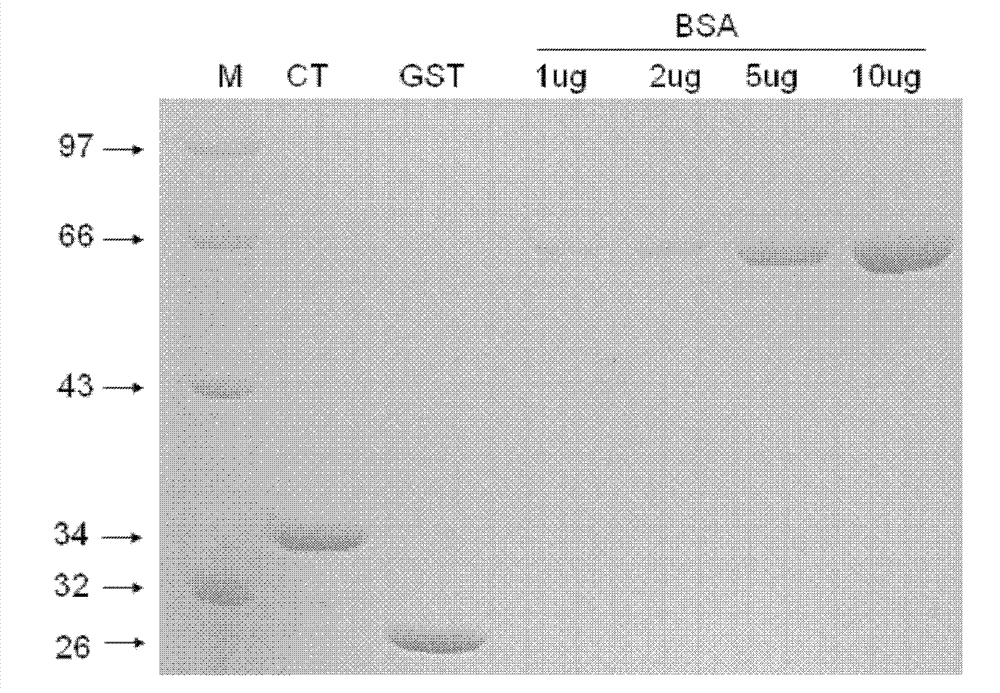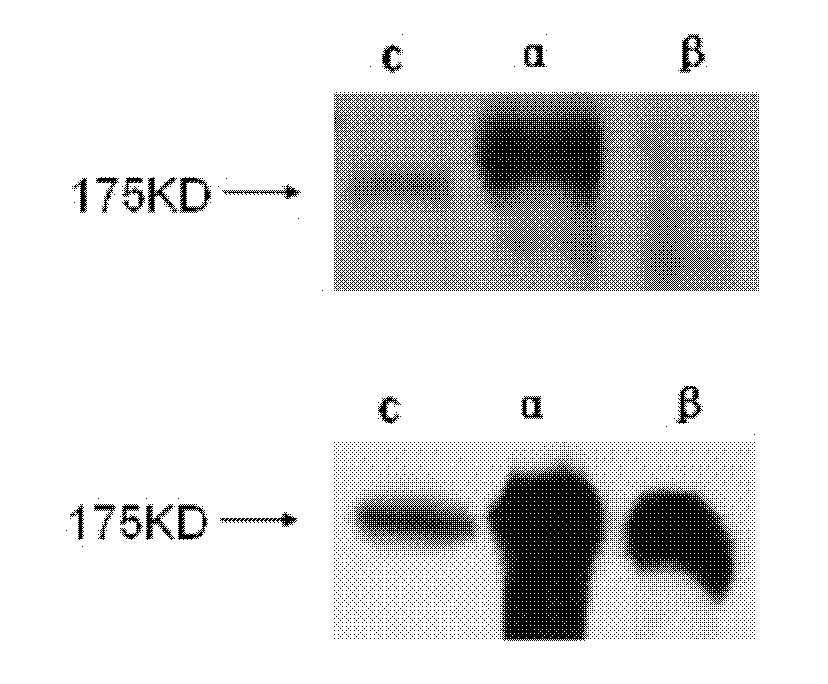PHF14 C-terminal protein, its polyclonal antibody and application thereof
A polyclonal antibody and protein technology, which is applied in the fields of application, anti-animal/human immunoglobulin, and the introduction of foreign genetic material using vectors, which can solve problems such as sequence differences
- Summary
- Abstract
- Description
- Claims
- Application Information
AI Technical Summary
Problems solved by technology
Method used
Image
Examples
Embodiment 1
[0100] Example 1, Preparation of PHF14 C-terminal protein
[0101] 1. Amplification of the nucleotide sequence of the PHF14C-terminal open reading frame
[0102] The open reading frame of the human PHF14 C-terminal protein gene was amplified from a human placenta cDNA library, and the primer sequences used for amplification were 5'CCGGAATTCTGTGATGAATGCAGACTCTG 3' (SEQ ID NO: 3) and 5'CCGCTCGAGTTTCTTTGGATTTTTCTGTT 3' (SEQ ID NO: 4). PCR conditions: 94°C for 5 minutes; 94°C for 1 minute, 63°C for 1 minute, 72°C for 3 minutes, a total of 20 cycles; 72°C for 5 minutes; keep warm at 4°C. After the product was digested with EcoRI and XhoI (37°C for 3 hours), it was ligated into the cloning vector pGex-5x-1 after the same double digestion with T4 DNA ligase (16°C overnight), and the ligated product was transformed into DH5α (Invitrogen company), after enzyme digestion and identification of positive clones, the C-terminus of the successfully constructed pGex-5x-1-PHF14 will be seque...
Embodiment 2
[0117] Example 2, PHF14 C-terminal protein gene-encoded protein-specific polyclonal antibody
[0118] The purified PHF14 C-terminal protein obtained in Example 1 was used as an antigen and immunized by subcutaneous multi-point injection to prepare the polyclonal antibody of the present invention.
[0119] New Zealand big-eared rabbits (Shanghai Institute of Biological Sciences Animal Experiment Center) of 2-2.5 kg routinely immunized with purified PHF14 C-terminal protein (antigen) back subcutaneously, first immunized with an equal amount of Freund's complete adjuvant (Sigma company) to emulsify the antigen (antigen: Freund's complete adjuvant = 1: 1), each mouse was injected with 1ml (containing 500ug of protein), and the antigen was emulsified with Freund's incomplete adjuvant (Sigma company) at intervals of four weeks (antigen: Freund's incomplete adjuvant = 1: 1) Repeat the injection in the same way, boost the immunization once, repeat the injection with the antigen (disso...
Embodiment 3
[0120] Example 3, Application of PHF14 C-terminal protein polyclonal antibody in Western Blot
[0121] Using the polyclonal antibody obtained in Example 2, Western Blot was used to detect the expression of endogenous and exogenous PHF14 proteins to distinguish the two isoforms of PHF14.
[0122] After the cultured 293A cells were fully lysed in RIPA buffer, sonicated, and then centrifuged at 12000 rpm at 4° C. for 10 minutes, the obtained supernatant was the 293A cell lysate. The PHF14 protein in the cell lysate was detected by standard Western Blot procedure. Proteins were transferred to nitrocellulose membranes (Schleicher & Schuell BioScience, Keene, NH). After blocking for one hour, the polyclonal antibody obtained in Example 2 was used for detection at a ratio of 1:1000, and this time was the detection of endogenous PHF14 protein.
[0123] The 293A cells transfected with Myc-PHF14α and Myc-PHF14β were also lysed by the same method, and the obtained supernatant was the o...
PUM
 Login to View More
Login to View More Abstract
Description
Claims
Application Information
 Login to View More
Login to View More - R&D
- Intellectual Property
- Life Sciences
- Materials
- Tech Scout
- Unparalleled Data Quality
- Higher Quality Content
- 60% Fewer Hallucinations
Browse by: Latest US Patents, China's latest patents, Technical Efficacy Thesaurus, Application Domain, Technology Topic, Popular Technical Reports.
© 2025 PatSnap. All rights reserved.Legal|Privacy policy|Modern Slavery Act Transparency Statement|Sitemap|About US| Contact US: help@patsnap.com



